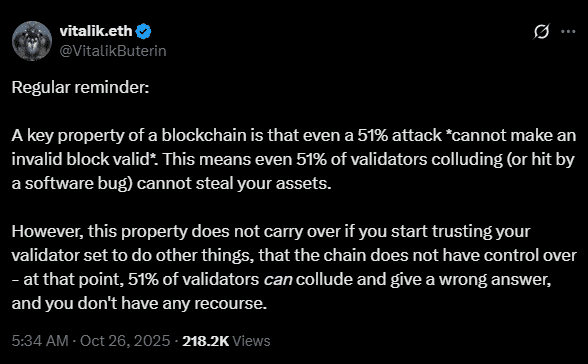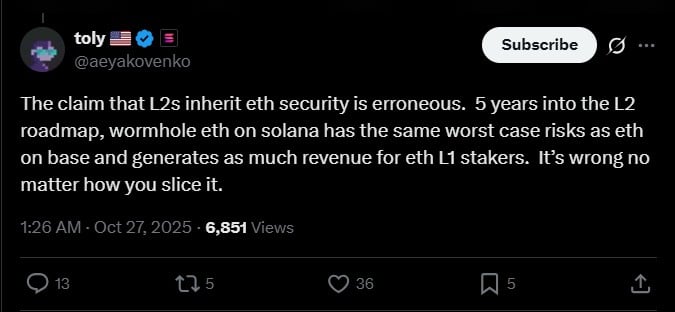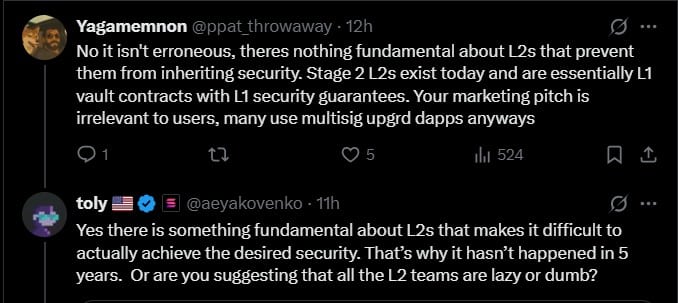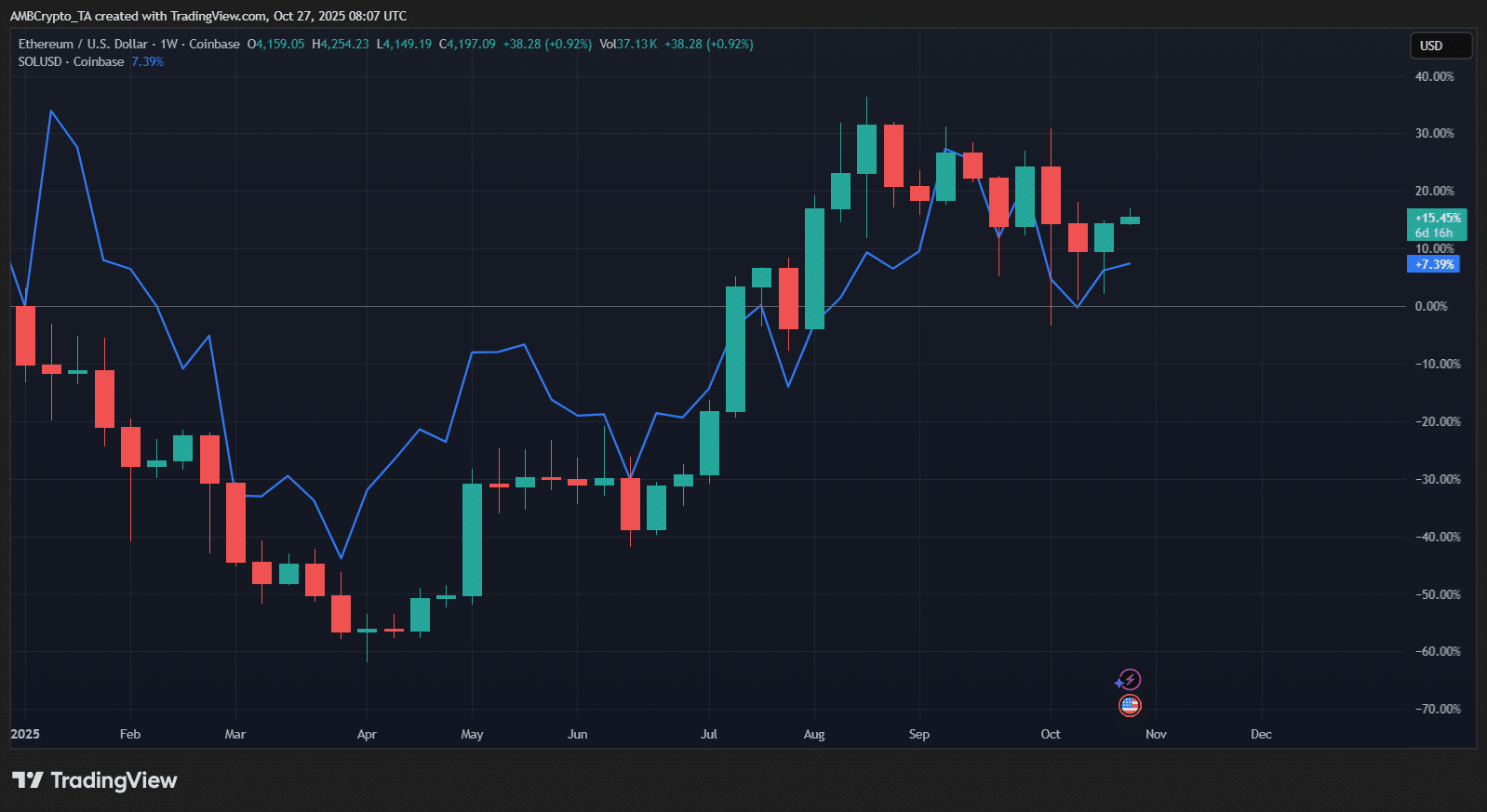| COINOTAG recommends • Exchange signup |
| 💹 Trade with pro tools |
| Fast execution, robust charts, clean risk controls. |
| 👉 Open account → |
| COINOTAG recommends • Exchange signup |
| 🚀 Smooth orders, clear control |
| Advanced order types and market depth in one view. |
| 👉 Create account → |
| COINOTAG recommends • Exchange signup |
| 📈 Clarity in volatile markets |
| Plan entries & exits, manage positions with discipline. |
| 👉 Sign up → |
| COINOTAG recommends • Exchange signup |
| ⚡ Speed, depth, reliability |
| Execute confidently when timing matters. |
| 👉 Open account → |
| COINOTAG recommends • Exchange signup |
| 🧭 A focused workflow for traders |
| Alerts, watchlists, and a repeatable process. |
| 👉 Get started → |
| COINOTAG recommends • Exchange signup |
| ✅ Data‑driven decisions |
| Focus on process—not noise. |
| 👉 Sign up → |
Ethereum’s layer-2 networks inherit core security from the main chain, but debates highlight ongoing risks like those in cross-chain bridges, as Vitalik Buterin and Anatoly Yakovenko recently discussed. Top L2s secure over $35 billion in value amid evolving protections.
-
Ethereum co-founder Vitalik Buterin affirms L2s’ security by leveraging the mainnet’s finality and validator strength.
-
Solana’s Anatoly Yakovenko counters that L2s still face fundamental risks similar to bridges after years of development.
-
Leading L2s like Arbitrum, Base, Optimism, and Worldchain hold over $35 billion in total value locked, backed by Ethereum’s one million validators.
Ethereum layer-2 security debate heats up: Vitalik Buterin vs. Anatoly Yakovenko on L2 risks and protections. Discover key insights and implications for investors. Stay informed on crypto scaling solutions today.
What is the Ethereum layer-2 security debate?
Ethereum layer-2 security centers on how scaling solutions like rollups protect user funds and transactions while relying on the main Ethereum chain. Vitalik Buterin argues that L2s inherit Ethereum’s robust finality, shielding them from 51% attacks, though he notes risks arise when validators handle external tasks. This debate, sparked by exchanges with Solana’s Anatoly Yakovenko, underscores the balance between innovation and safety in blockchain scaling.
| COINOTAG recommends • Professional traders group |
| 💎 Join a professional trading community |
| Work with senior traders, research‑backed setups, and risk‑first frameworks. |
| 👉 Join the group → |
| COINOTAG recommends • Professional traders group |
| 📊 Transparent performance, real process |
| Spot strategies with documented months of triple‑digit runs during strong trends; futures plans use defined R:R and sizing. |
| 👉 Get access → |
| COINOTAG recommends • Professional traders group |
| 🧭 Research → Plan → Execute |
| Daily levels, watchlists, and post‑trade reviews to build consistency. |
| 👉 Join now → |
| COINOTAG recommends • Professional traders group |
| 🛡️ Risk comes first |
| Sizing methods, invalidation rules, and R‑multiples baked into every plan. |
| 👉 Start today → |
| COINOTAG recommends • Professional traders group |
| 🧠 Learn the “why” behind each trade |
| Live breakdowns, playbooks, and framework‑first education. |
| 👉 Join the group → |
| COINOTAG recommends • Professional traders group |
| 🚀 Insider • APEX • INNER CIRCLE |
| Choose the depth you need—tools, coaching, and member rooms. |
| 👉 Explore tiers → |
How do Vitalik Buterin and Anatoly Yakovenko differ on L2 risks?
Vitalik Buterin emphasizes that Ethereum’s layer-2 networks benefit from the mainnet’s over one million validators, ensuring high security against common threats. He states that L2s achieve finality through Ethereum’s proof-of-stake consensus, making them resilient as long as they stay within the ecosystem’s controls. However, Buterin acknowledges potential vulnerabilities if L2 operations extend beyond direct Ethereum oversight, such as in decentralized sequencer management.
Anatoly Yakovenko challenges this view, calling Buterin’s assessment erroneous and comparing L2s to insecure cross-chain bridges like Wormhole, which have suffered major exploits. Yakovenko points out that despite five years of progress, fundamental challenges persist in fully inheriting Ethereum’s security without introducing new attack vectors, like those in optimistic or zero-knowledge rollups. An Ethereum advocate countered that nothing inherently prevents L2s from gaining full mainnet protection, citing Stage 2 rollups that function like secure vault contracts on layer-1.
| COINOTAG recommends • Exchange signup |
| 📈 Clear interface, precise orders |
| Sharp entries & exits with actionable alerts. |
| 👉 Create free account → |
| COINOTAG recommends • Exchange signup |
| 🧠 Smarter tools. Better decisions. |
| Depth analytics and risk features in one view. |
| 👉 Sign up → |
| COINOTAG recommends • Exchange signup |
| 🎯 Take control of entries & exits |
| Set alerts, define stops, execute consistently. |
| 👉 Open account → |
| COINOTAG recommends • Exchange signup |
| 🛠️ From idea to execution |
| Turn setups into plans with practical order types. |
| 👉 Join now → |
| COINOTAG recommends • Exchange signup |
| 📋 Trade your plan |
| Watchlists and routing that support focus. |
| 👉 Get started → |
| COINOTAG recommends • Exchange signup |
| 📊 Precision without the noise |
| Data‑first workflows for active traders. |
| 👉 Sign up → |
Yakovenko reiterated the unsolved nature of these issues, stressing that L2s’ reliance on off-chain components could still expose them to worst-case scenarios. This exchange, shared publicly on X (formerly Twitter), has fueled discussions among developers, with data from sources like DefiLlama showing top L2s managing $35 billion in total value locked without recent major breaches.

| COINOTAG recommends • Traders club |
| ⚡ Futures with discipline |
| Defined R:R, pre‑set invalidation, execution checklists. |
| 👉 Join the club → |
| COINOTAG recommends • Traders club |
| 🎯 Spot strategies that compound |
| Momentum & accumulation frameworks managed with clear risk. |
| 👉 Get access → |
| COINOTAG recommends • Traders club |
| 🏛️ APEX tier for serious traders |
| Deep dives, analyst Q&A, and accountability sprints. |
| 👉 Explore APEX → |
| COINOTAG recommends • Traders club |
| 📈 Real‑time market structure |
| Key levels, liquidity zones, and actionable context. |
| 👉 Join now → |
| COINOTAG recommends • Traders club |
| 🔔 Smart alerts, not noise |
| Context‑rich notifications tied to plans and risk—never hype. |
| 👉 Get access → |
| COINOTAG recommends • Traders club |
| 🤝 Peer review & coaching |
| Hands‑on feedback that sharpens execution and risk control. |
| 👉 Join the club → |
Image source: X (formerly Twitter)

Image source: X (formerly Twitter)

| COINOTAG recommends • Exchange signup |
| 📈 Clear control for futures |
| Sizing, stops, and scenario planning tools. |
| 👉 Open futures account → |
| COINOTAG recommends • Exchange signup |
| 🧩 Structure your futures trades |
| Define entries & exits with advanced orders. |
| 👉 Sign up → |
| COINOTAG recommends • Exchange signup |
| 🛡️ Control volatility |
| Automate alerts and manage positions with discipline. |
| 👉 Get started → |
| COINOTAG recommends • Exchange signup |
| ⚙️ Execution you can rely on |
| Fast routing and meaningful depth insights. |
| 👉 Create account → |
| COINOTAG recommends • Exchange signup |
| 📒 Plan. Execute. Review. |
| Frameworks for consistent decision‑making. |
| 👉 Join now → |
| COINOTAG recommends • Exchange signup |
| 🧩 Choose clarity over complexity |
| Actionable, pro‑grade tools—no fluff. |
| 👉 Open account → |
Image source: X (formerly Twitter)
Frequently Asked Questions
Are Ethereum layer-2 networks as secure as the main chain?
Ethereum layer-2 networks inherit much of the main chain’s security through mechanisms like fraud proofs and validity proofs, backed by over one million validators. While they reduce congestion effectively, experts like Vitalik Buterin note that full equivalence requires careful design to avoid off-chain risks. No major L2 exploits have occurred recently, but ongoing audits are essential.
| COINOTAG recommends • Members‑only research |
| 📌 Curated setups, clearly explained |
| Entry, invalidation, targets, and R:R defined before execution. |
| 👉 Get access → |
| COINOTAG recommends • Members‑only research |
| 🧠 Data‑led decision making |
| Technical + flow + context synthesized into actionable plans. |
| 👉 Join now → |
| COINOTAG recommends • Members‑only research |
| 🧱 Consistency over hype |
| Repeatable rules, realistic expectations, and a calmer mindset. |
| 👉 Get access → |
| COINOTAG recommends • Members‑only research |
| 🕒 Patience is an edge |
| Wait for confirmation and manage risk with checklists. |
| 👉 Join now → |
| COINOTAG recommends • Members‑only research |
| 💼 Professional mentorship |
| Guidance from seasoned traders and structured feedback loops. |
| 👉 Get access → |
| COINOTAG recommends • Members‑only research |
| 🧮 Track • Review • Improve |
| Documented PnL tracking and post‑mortems to accelerate learning. |
| 👉 Join now → |
What risks do L2 solutions face according to Anatoly Yakovenko?
Anatoly Yakovenko highlights that Ethereum’s L2s encounter the same core risks as cross-chain bridges, including potential failures in state validation and sequencer centralization. He argues these issues remain after years of iteration, urging developers to address fundamental flaws for true security inheritance. This perspective encourages vigilance in the crypto community for safer scaling.

| COINOTAG recommends • Exchange signup |
| 🎯 Focus on process over noise |
| Plan trades, size positions, execute consistently. |
| 👉 Sign up → |
| COINOTAG recommends • Exchange signup |
| 🛠️ Simplify execution |
| Keep decisions clear with practical controls. |
| 👉 Get started → |
| COINOTAG recommends • Exchange signup |
| 📊 Make data your edge |
| Use depth and alerts to avoid guesswork. |
| 👉 Open account → |
| COINOTAG recommends • Exchange signup |
| 🧭 Be prepared, not reactive |
| Turn setups into rules before you trade. |
| 👉 Create account → |
| COINOTAG recommends • Exchange signup |
| ✍️ Plan first, then act |
| Entries, exits, and reviews that fit your routine. |
| 👉 Join now → |
| COINOTAG recommends • Exchange signup |
| 🧩 Consistency beats intensity |
| Small, repeatable steps win the long run. |
| 👉 Sign up → |
Image source: TradingView
Key Takeaways
- Ethereum L2 security inheritance: Vitalik Buterin confirms layer-2 networks leverage mainnet finality, protecting against 51% attacks with over $35 billion in TVL secured.
- Ongoing risks highlighted: Anatoly Yakovenko warns of persistent vulnerabilities akin to bridge exploits, despite five years of development in Ethereum layer-2 solutions.
- Market performance insight: Ethereum and Solana prices have mirrored each other over the past year, with ETH up 15.45% and SOL up 7.39%, signaling broader ecosystem stability.
Conclusion
The Ethereum layer-2 security debate between Vitalik Buterin and Anatoly Yakovenko reveals the nuanced balance in blockchain scaling, where innovations like rollups enhance efficiency but demand rigorous safeguards. As top networks secure substantial value, ongoing upgrades will be crucial to mitigating risks. Investors should monitor these developments closely, as they could shape the future of decentralized finance and Ethereum’s dominance in the crypto space.
| COINOTAG recommends • Premium trading community |
| 🏛️ WAGMI CAPITAL — Premium Trading Community |
| Strategic insights, exclusive opportunities, professional support. |
| 👉 Join WAGMI CAPITAL → |
| COINOTAG recommends • Premium trading community |
| 💬 Inner Circle access |
| See members share real‑time PnL and execution notes in chat. |
| 👉 Apply for Inner Circle → |
| COINOTAG recommends • Premium trading community |
| 🧩 Turn theses into trades |
| Reusable templates for entries, risk, and review—end to end. |
| 👉 Join the club → |
| COINOTAG recommends • Premium trading community |
| 💡 Long‑term mindset |
| Patience and discipline over noise; a process that compounds. |
| 👉 Get started → |
| COINOTAG recommends • Premium trading community |
| 📚 Education + execution |
| Courses, playbooks, and live market walkthroughs—learn by doing. |
| 👉 Get access → |
| COINOTAG recommends • Premium trading community |
| 🔒 Members‑only research drops |
| Curated analyses and private briefings—quality over quantity. |
| 👉 Join WAGMI CAPITAL → |
| COINOTAG recommends • Members‑only research |
| 📌 Curated setups, clearly explained |
| Entry, invalidation, targets, and R:R defined before execution. |
| 👉 Get access → |
| COINOTAG recommends • Members‑only research |
| 🧠 Data‑led decision making |
| Technical + flow + context synthesized into actionable plans. |
| 👉 Join now → |
| COINOTAG recommends • Members‑only research |
| 🧱 Consistency over hype |
| Repeatable rules, realistic expectations, and a calmer mindset. |
| 👉 Get access → |
| COINOTAG recommends • Members‑only research |
| 🕒 Patience is an edge |
| Wait for confirmation and manage risk with checklists. |
| 👉 Join now → |
| COINOTAG recommends • Members‑only research |
| 💼 Professional mentorship |
| Guidance from seasoned traders and structured feedback loops. |
| 👉 Get access → |
| COINOTAG recommends • Members‑only research |
| 🧮 Track • Review • Improve |
| Documented PnL tracking and post‑mortems to accelerate learning. |
| 👉 Join now → |








